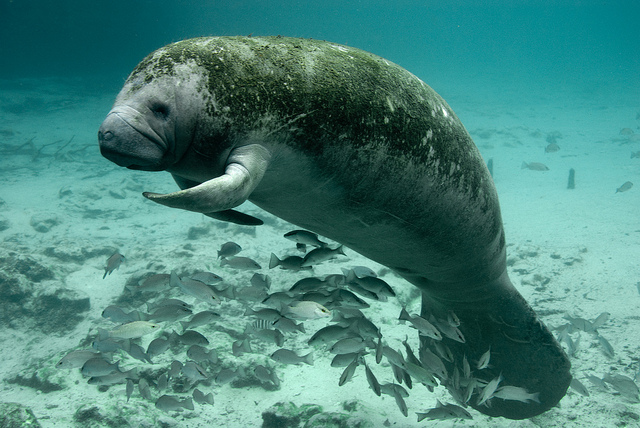Amazonian Manatee
The Amazonian Manatee (Trichechus inunguis) is a species of manatee of the order Sirenia. It is found living in the freshwater habitats of the Amazon Basin in Brazil, Peru, Bolivia, Colombia and Ecuador. It has thin, wrinkled skin, and is almost hairless, but has "whiskers" around its mouth. It also has a distinct white breast patch, with fine hairs scattered over its body.It is also known as the Amazon Manatee sea cow. It can be found in Belem at the Botanic Gardens "Bosque Rodrigues Alves"
The Amazonian manatee is the second-smallest species of manatee after the dwarf manatee (Trichechus pygmaeus) from Brazil. However, the validity of the dwarf manatee as a species is the subject of debate, with some believing it to be an immature Amazonian manatee.
They live exclusively in freshwater habitat.The species relies on changes in the peripheral circulation for its primary mechanism for thermoregulation by using sphincters to deflect blood flow from areas of the body in close contact with ocean. They also rely on subcutaneous fat to reduce heat loss.
Manatees have nostrils, not blowholes like other aquatic mammals, which close when under water to keep water out and open when above water to breath.Although manatees can remain under water for extended periods, surfacing for air about every five minutes is common. The longest documented submergence of an Amazonian manatee in captivity is 14 minutes.
The Amazonian manatee (T. inunguis) inhabits the Amazon River and associated drainage areas, including seasonally inundated forests. This species lives only in fresh water and can be found far inland through Brazil to Ecuador, Peru, and Colombia. The West African manatee (T. senegalensis), found in coastal areas and slow-moving rivers from Senegal to Angola, also ranges far inland in some rivers.
Manatees are uniquely adapted for eating aquatic plants. The manatee large lips are prehensile and studded with specialized sensory bristles and hairs (vibrissae) for discriminating between and manipulating food plants. Compared with the fish and krill eaten by other marine mammals, most aquatic plants are low in energy value and protein. Manatees must therefore eat large amounts of this bulky, low-energy food to satisfy their dietary requirements. To handle such a diet, manatees are hindgut digesters (like horses) and have intestines as long as 30 metres (100 feet). The teeth have also evolved in response to dietary demands. To counter abrasion from ingested sand and silica, manatees constantly grow new molars. These teeth progress from the rear of the jaws forward as older, worn teeth drop out at the front of the mouth. Unlike almost all other mammals, tooth replacement occurs throughout life.
learn more in
http://www.wikipedia.org
http://global.britannica.com/animal/manatee#ref14338

